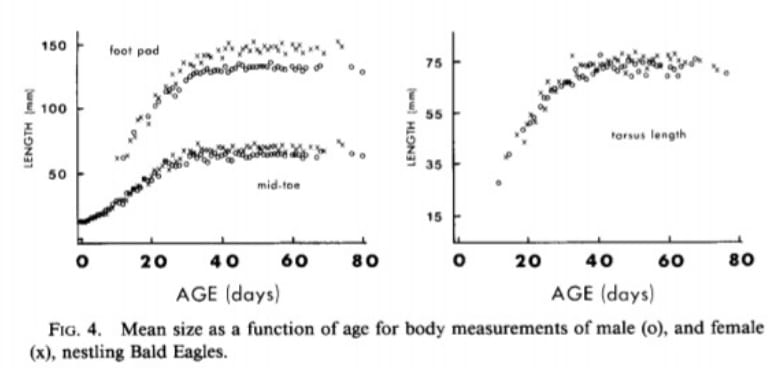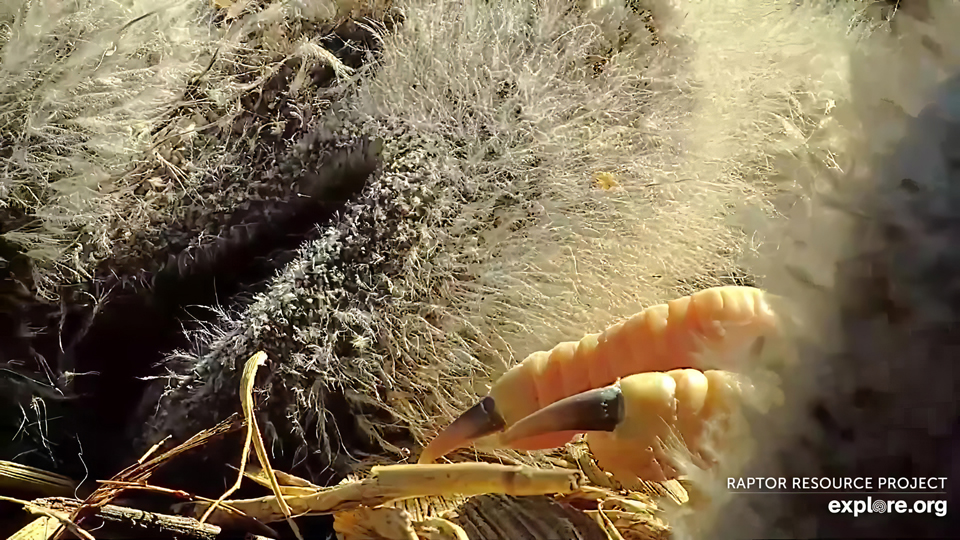We’re writing a series of blogs about the first few weeks of an eaglet’s life. An eaglet spends roughly 75 to 80 days in the nest. For about the first half, it grows and gains weight. For about the second half, it grows flight feathers and starts developing the skills it will need post-fledge. We will focus on week three in this blog.
DN17 and DN18 turned 15 and 14 days old today. During week two (seven to 14 days), their footpads and talons grew, their feet and legs yellowed, their talons started turning black, and their grey thermal down started sprouting! During week one – especially the first few days – DNF and Mr. North did their best to carefully place tiny morsels of meat into gaping, sometimes unsteady beaks. During week two, they dangled larger strips of flesh for their hungry eaglet to lunge at, improving visual acuity and feeding skills. The eaglets had a fine buffet to chose from, including trout from the stream (look for finer scales and a front pointing mouth with thin lips), sucker (look for rougher scales and a bottom pointing mouth with fleshy lips), and a deer or cow fetus. Of course, all that food resulted in a whole lot of eaglet poop. The terrific two got better at sitting up, bending over, and shooting poop, although sometimes parents got in the way!
Last year, we watched HD and HM rise a single eaglet in the Decorah nest. This year, we’re watching ‘eagle twins’ at Decorah North. It’s a great deal of fun to watch them interact with one another, especially now that bonking has (mostly) subsided. You’ve asked whether singleton eaglets have different social experiences and interactions once they leave the nest. We can’t answer that, but a study of precocial birds found that isolated birds displayed different auditory and visual preferences than birds who were allowed to interact with nest and creche mates. It’s also just fun to watch the terrific two learn and become eaglets together. Whatever happens after nest life – and we truly don’t know – filial imprinting (think play, observation, competition, allopreening, and vocalizing) is an enjoyable part of nest watching, an important part of early eagle learning, and something we started to see a lot of late in the second week.
We also saw whole lot of eating and sleeping during week two. While big changes are on the way, week three (14 to 21 days) will involve a whole lot more eating and sleeping as DN17 and DN18 continue to gain wait and start sprouting pinfeathers!
Here are some things to watch for:
- Mohawks! Natal down disappears from the head last, which will give the two a distinctly punk rawk vibe in the next seven days or so.
- Cropzillas so heavy that DN17 and DN18 have a hard time sitting up! Given that bites now include scales and fur, we will likely see pellet casting soon.
- Pinfeathers! Look for pinfeathers to start emerging along the edges of their wings.
- Eaglet explorers! While neither eaglet can stand on its feet yet, they are getting stronger and more coordinated. Cross your fingers for some eaglet exploration on the next warm, dry day!
- Clown clompers! Feet pads and legs/tarsi will grow like crazy, as this chart from Gary Bortolotti shows! You think those footpads are big now? https://youtu.be/rQIHSYb-EVA?si=8t5LaSfd62vez7gU Just wait!

 April 6, 2024: Look at those clown clompers! The eaglets’ feet and legs have turned orange and are growing rapidly. It won’t be long before they can stand on their feet.
April 6, 2024: Look at those clown clompers! The eaglets’ feet and legs have turned orange and are growing rapidly. It won’t be long before they can stand on their feet.
By the end of week three, the terrific two will be about 25% of the way through life in the nest. Our adorable little fuzzballs will have been (mostly) replaced by large grey tween eagles. Enjoy white down and earholes while you can!
The general stages of eagle development are:
- Stage 1 – Structural growth. In their first thirty-five to forty days of life, eagles grow very rapidly, gaining weight and building bones, muscles, tissue, and features like tarsi, footpads, toes, and claws. This phase of development slows down about halfway through an eaglet’s time in the nest, even though individual features might continue some level of growth.
- Stage 2 – Feather and flight-related growth. Eagles grow four sets of feathers – natal down inside the egg, thermal down, juvenile feathers, and adult feathers. Thermal down starts growing at about ten days, juvenile deck feathers at about 20-23 days and juvenile flight feathers at about 27 days, but feather growth doesn’t overtake structural growth until thirty-five to forty days after hatch. Flight muscles also begin growing as eaglets wingercize, flap, hover, and eventually branch and fledge.
- Neurological coordination occurs throughout an eaglet’s time in the nest. During week two, their eyesight and basic coordination skills are improving as they grab food from Mom and Dad, sit up tall for feedings, shuffle around on their tarsi, and explore the world with their sensitive beaks. As they grow, they will become more adept at controlling beaks, legs, wings, and feet. They will learn to stand on their own feet, tear food, self-feed, and flap their wings, going from cute but clumsy clown clompers to graceful young eaglets poised at the edge of fledge.
I’m not sure how familiar many of you are with the cortical homunculus, an image-based tool that maps tactility. While useful and extremely cool, most cortical homunculii are static – that is, they reflect just one phase (usually adult) of an organism’s life. But an eaglet’s cortical homunculus will differ from an adult’s as body parts and associated skills are gained and neural pathways developed. Our eaglets’ brains and bodies are rapidly growing and changing as they gain the skills they need for life outside the egg! Areas related to visual acuity, strength, and coordination all ‘lit up’ in week two as the eaglets got better at perceiving things at a distance, improved their poop shooting, reached for food, took bigger bites, and started exploring!
Things that helped me write this blog, with a few considerations:
- Eaglet weight and growth is based on Gary Bortolotti’s work with eaglets at Besnard Lake in Canada. It is possible that our eaglets are a little smaller than his, since Bald eagles get bigger the farther north one travels: a phenomena known as Bergmann’s Rule. Bortolotti’s paper makes for interesting reading and provides a great look at the work involved in field science. Citation: Physical Development of Nestling Bald Eagles with Emphasis on the Timing of Growth Events, The Wilson Bulletin, Vol. 96, No. 4 (Dec., 1984), pp. 524-54. https://www.usask.ca/biology/bortolotti/pubs/wb96-4-524-542.pdf
- Mouseunculus: http://phenomena.nationalgeographic.com/2013/07/24/mouseunculus-how-the-brain-draws-a-little-you/
- Homunculus: http://io9.com/5670064/how-your-brain-sees-your-body-meet-the-cortical-homunculus
- Input from Bob Anderson, who imparted much wisdom and information before he passed.
- RRP moderators and their calendars, lists, books, charts, and personal observations.
 The Raptor Resource Project
The Raptor Resource Project The Raptor Resource Project
The Raptor Resource Project